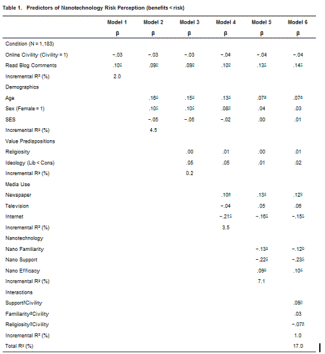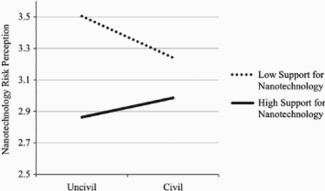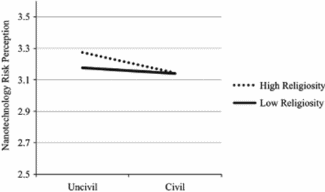ReferencesBrossard, D., & Nisbet, M. C. (2007). Deference to scientific authority among a low information public: Understanding US opinion on agricultural biotechnology. International Journal of Public Opinion Research, 19(1), 24–52.
CrossRef,Web of Science® Times Cited: 41
Brossard, D., Scheufele, D. A., Kim, E., & Lewenstein, B. V. (2009). Religiosity as a perceptual filter: Examining processes of opinion formation about nanotechnology. Public Understanding of Science, 18(5), 546–558.
CrossRef,Web of Science® Times Cited: 28
Brossard, D. & Shanahan, J. (2006) Do they know what they read? Building a scientific literacy measurement instrument based on science media coverage. Science Communication, 28(1), 47–63.
CrossRef,Web of Science® Times Cited: 7
Cacciatore, M. A., Scheufele, D. A., & Corley, E. A. (2011). From enabling technology to applications: The evolution of risk perceptions about nanotechnology. Public Understanding of Science, 20(3), 385–404.
CrossRef,Web of Science® Times Cited: 7
Cappella, J., & Jamieson, K. (1997). Spiral of cynicism: The press and the public good. New York: Oxford University Press, USA.
Dietz, T., Frey, R., & Rosa, E. (2002). Risk, technology and society. In R. Dunlap & W. Michelson (Eds.), Handbook of environmental sociology (pp. 562–629). Westport, CT: Greenwood Publishing Group, Inc.
Dutton, W. (1996). Network rules of order: Regulating speech in public electronic fora. Media, Culture & Society, 18(2), 269.
CrossRef,Web of Science® Times Cited: 16
Eagly, A., & Chaiken, S. (1993). The psychology of attitudes. Forth Worth, TX: Harcourt Brace Jovanovich College Publishers.
Elving, R. (1994). Brighter lights, wider windows: Presenting Congress in the 1990s. Washington D.C: American Enterprise Institute and The Brookings Institution.
Funk, C. L. (2001). Process performance: Public reaction to legislative policy debate. In J. R. Hibbing & E. Theiss-Morse (Eds.), What is it about government that Americans dislike? (pp. 193–204). New York: Cambridge University Press.
Hill, K., & Hughes, J. (1998). Cyberpolitics: Citizen activism in the age of the Internet. New York: Rowman & Littlefield Publishers, Inc.
Hwang, H., Borah, P., Namkoong, K., & Veenstra, A. (2008, May). Does civility matter in the blogosphere? Examining the interaction effects of incivility and disagreement on citizen attitudes. Paper presented at the 58th Annual Conference of the International Communication Association, Montreal, QC, Canada.
Jamieson, K. (1997). Civility in the House of Representatives. APPC report 10. Retrieved March 28, 2011, from
http://democrats.rules.house.gov/archives/hear01.html.
Janofsky, M. (2005). When cleaner air is a biblical obligation. New York Times. Retrieved from
http://www.nytimes.com/2005/11/07/politics/07air.html.
Kahan, D. M., Braman, D., Slovic, P., Gastil, J., & Cohen, G. (2009). Cultural cognition of the risks and benefits of nanotechnology. Nature Nanotechnology, 4(2), 87–90.
CrossRef,PubMed,CAS,Web of Science® Times Cited: 54,ADS
Kahan, D. M., Slovic, P., Braman, D., Gastil, J., & Cohen, G. (2007). Nanotechnology risk perceptions: The influence of affect and values. New Haven, CT: Yale Law School.
Kasperson, R. E., Renn, O., Slovic, P., Brown, H. S., Emel, J., Goble, R., et al. (1988). The social amplification of risk: A conceptual framework. Risk Analysis, 8(2), 177–187.
Direct Link:AbstractPDF(923K)ReferencesWeb of Science® Times Cited: 542
King, A. (2001). Affective dimensions of Internet culture. Social Science Computer Review, 19(4), 414.
CrossRef
Krimsky, S., & Golding, D. (1992). Social theories of risk. Westport, CT: Praeger.
Ladwig, P., Dalrymple, K. E., Brossard, D., Scheufele, D. A., & Corley, E. A. (2012). Perceived or factual knowledge? Comparing operationalizations of scientific understanding. Science and Public Policy. Advance online publication. doi: 10.1093/scipol/scs048.
CrossRef,Web of Science®
Lee, C. J., & Scheufele, D. A. (2006). The influence of knowledge and deference toward scientific authority: A media effects model for public attitudes toward nanotechnology. Journalism & Mass Communication Quarterly, 83(4), 819–834.
CrossRef
McGraw, K., Willey, E., & Anderson, W. (1999, April). It's the process stupid!? Procedural considerations in evaluations of congress. Paper presented at the Annual Meeting of the Midwest Political Science Association, Chicago, IL.
Michaud, K. (2008). The good steward: The impact of religion on climate change attitudes. Paper presented at the APSA 2008 Annual Meeting.
Mutz, D. C. (2007). Effects of in-your-face television discourse on perceptions of a legitimate opposition. American Political Science Review, 101(4), 621–635.
CrossRef
Mutz, D. C., & Reeves, B. (2005). The new videomalaise: Effects of televised incivility on political trust. American Political Science Review, 99(1), 1–15.
CrossRef
National Nanotechnology Initiative. (2011). What is nanotechnology? Retrieved March 28, 2011, from
http://www.nano.gov/html/facts/whatIsNano.html.
Ng, E., & Detenber, B. (2005). The impact of synchronicity and civility in online political discussions on perceptions and intentions to participate. Journal of Computer-Mediated Communication 10(3).
Web of Science® Times Cited: 1Nisbet, M. C., & Mooney, C. (2007). Science and society: Framing science. Science, 316(5821), 56.
CrossRef,PubMed,CAS,Web of Science® Times Cited: 69
Nisbet, M. C., & Nisbet, E. C. (2005). Evolution and intelligent design: Understanding public opinion. Geotimes, 50, 28–33.
Web of Science® Times Cited: 2Nisbet, M. C., & Scheufele, D. A. (2007). The future of public engagement. Scientist, 21(10), 38–44.
Web of Science® Times Cited: 16
NRC. (1983). Risk assessment in the federal government: Managing the process: National Academy Press, Washington, DC.
Papacharissi, Z. (2002). The virtual sphere: The Internet as a public sphere. New Media & Society, 4(1), 9–27.
CrossRef,Web of Science® Times Cited: 114
Papacharissi, Z. (2004). Democracy online: civility, politeness, and the democratic potential of online political discussion groups. New Media & Society, 6(2), 259–283.
CrossRef,Web of Science® Times Cited: 53
Patterson, T. (1993). Out of order. New York: Alfred A. Knopf.
Peter D. Hart Associates. (2007). Awareness of and attitudes toward nanotechnology and federal regulatory agencies. Washington D.C.: Peter D. Hart Research Associates, Inc.
Phillips, T., & Smith, P. (2004). Emotional and behavioural responses to everyday incivility: Challenging the fear/avoidance paradigm. Journal of Sociology, 40(4), 378.
CrossRef,Web of Science® Times Cited: 6
Popkin, S. L. (1991). The reasoning voter: Communication and persuasion in presidential campaigns. Chicago: University of Chicago Press.
Price, V., Nir, L., & Cappella, J. (2006). Normative and informational influences in online political discussions. Communication Theory, 16(1), 47.
Direct Link:AbstractFull Article (HTML)PDF(181K)ReferencesWeb of Science® Times Cited: 29
Prior, M. (2007). Post-broadcast democracy: How media choice increases inequality in political involvement and polarizes elections. Cambridge, MA: Cambridge University Press.
Project on Emerging Nanotechnologies. (2011). An inventory of nanotechnology-based consumer products currently on the market. Retrieved March 28, 2011, from
http://www.nanotechproject.org/inventories/consumer/.
Renn, O., Burns, W. J., Kasperson, J. X., Kasperson, R. E., & Slovic, P. (1992). The social amplification of risk: Theoretical foundations and empirical applications. Journal of Social Issues, 48(4), 137–160.
Direct Link:AbstractPDF(1170K)References
Robinson, M., & Appel, K. (1979). Network news coverage of Congress. Political Science Quarterly, 94(3), 407–418.
CrossRef,Web of Science® Times Cited: 24
Satterfield, T., Kandlikar, M., Beaudrie, C. E. H., Conti, J., & Harthorn, B. H. (2009). Anticipating the perceived risk of nanotechnologies. Nature Nanotechnology 4(11), 752–758.
CrossRef,CAS,Web of Science® Times Cited: 35,ADS
Scheufele, D. A., & Lewenstein, B. V. (2005). The public and nanotechnology: How citizens make sense of emerging technologies. Journal of Nanoparticle Research, 7(6), 659–667.
CrossRef,Web of Science® Times Cited: 113
Shils, E. (1992). Civility and civil society. New York: Paragon House Publishers.
Sigelman, L., & Bullock, D. (1991). Candidates, issues, horse races, and hoopla: Presidential campaign coverage, 1888–1988. American Politics Research, 19(1), 5–32.
CrossRef,Web of Science® Times Cited: 25
Sjöberg, L. (2004). Principles of risk perception applied to gene technology. EMBO reports, 5(Suppl 1), S47-S51.
CrossRef,CAS,Web of Science® Times Cited: 15
Sjöberg, L., & Winroth, E. (1986). Risk, moral value of actions, and mood. Scandinavian Journal of Psychology, 27(1), 191–208.
Direct Link:AbstractPDF(1064K)ReferencesWeb of Science® Times Cited: 25
Smith, G., John, P., Sturgis, P., & Nomura, H. (2009, September). Deliberation and Internet engagement: Initial findings from a randomised controlled trial evaluating the impact of facilitated internet forums. Paper presented at the European Consortium of Political Research General Conference, Potsdam.
Uslaner, E. (1993). The decline of comity in Congress. Ann Arbor: University of Michigan Press.
Wilson, J. (2006). How divided are we? Commentary 121(2), 15.
Web of Science® Times Cited: 1



